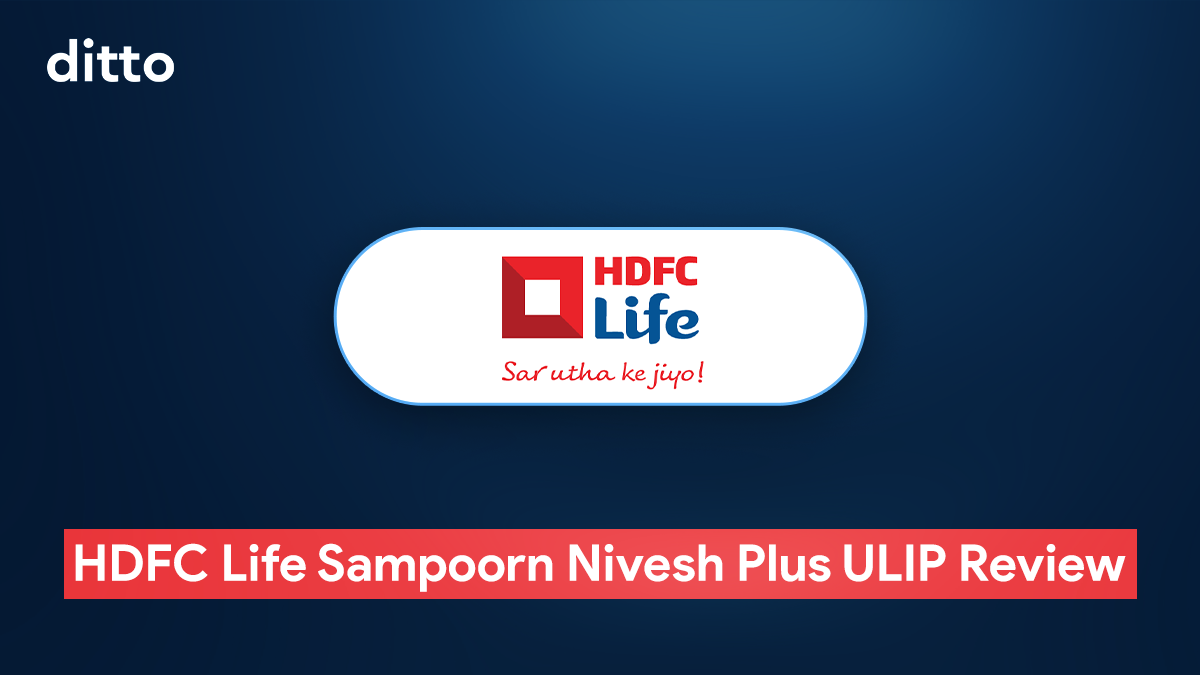HDFC Life Sampoorn Nivesh Plus is a ULIP that aims to strike a balance, offering market-driven returns on one side and life insurance protection on the other. With features such as premium waivers, nominee income benefits, and an impressive lineup of investment funds, it appears to be a well-rounded long-term plan.
However, once we moved past the sales pitch and actually ran the numbers, using two real-world scenarios, one with a 30-year-old opting for the Classic Waiver Plus variant and another with a 55-year-old opting for the Classic option, the cracks began to show.
In this breakdown, we’ll walk you through what this policy actually delivers from how much it costs and how the benefits stack up to whether it stands a chance against other ULIPs or a term plan + mutual fund combo.
Heads up: It takes an average person up to 5 hours to read and analyze a policy and 10 hours or more to compare different plans and decide.
We propose a better alternative: a 30-minute FREE consultation with Ditto’s certified advisors. We have a spam-free guarantee and will never push you to buy a plan. Don’t delay—we have limited slots daily, so book a quick call here before they run out.
Quick Overview: What Is HDFC Life Sampoorn Nivesh Plus?
HDFC Life Sampoorn Nivesh Plus is a Unit Linked Insurance Plan (ULIP) that aims to be a one-stop solution for your investment and insurance needs. On the surface, it promises to help you build long-term wealth while also providing a safety net for your family, all wrapped into one flexible plan.
You pay annual premiums, select from a mix of 11 funds (including pure equity, balanced, and debt options), and choose a plan variant (out of the five available) that suits your financial goals. In exchange, the insurer offers a bundle of benefits that look attractive, at least on paper.
Some of the headlining features include:
- Its death benefit, which, in most cases, is 7-10 times the annual premiums, can grow to over 40 times the yearly premiums as well, with the addition of market-linked returns. It depends on your age, policy type, and the insurer's underwriting.
- Fund choices tailored to different risk profiles, with full equity exposure if want to be more aggressive.
- The multiple plan variants that offer distinct benefits, such as:
- Classic Waiver Plus – ensures your nominee receives monthly income equal to 0.5%-2% of the sum assured and future premiums are waived in case of your untimely death. The policy continues to stay in force and pays the fund value at maturity.
- Classic Plus – combines the chosen fund value (depending on market performance) with the sum assured for a higher payout on death or maturity
- Loyalty Additions that start from the 10th year onward
- Return of Mortality Charges (ROMC): Under the Classic Waiver Plus option, HDFC Life refunds a portion of the mortality charges deducted during the policy term if you survive till maturity.
- Riders like premium waiver or accidental death benefits, often at no extra cost
On paper, it checks a lot of boxes. But as we dug deeper into real-life policy illustrations and cost breakdowns, we found that the benefits come with a few strings attached, and those can make or break the value this plan claims to deliver.
Does HDFC Life Sampoorn Nivesh Plus Offer Strong Life Cover?
Let’s be clear, life insurance is a fundamental component of any ULIP. It’s not a bonus; it’s baked into the structure by design. So, when a ULIP claims to offer life cover, the real question is: how much? And is it enough?
With HDFC Life Sampoorn Nivesh Plus, the answer depends on the option you choose. Under the most commonly opted variant, Classic, the death benefit is simply the higher of:
- The fund value
- 10-40× your annual premium (for policyholders below age 50)
- 105% of total premiums paid
Which, frankly, is standard across most ULIPs.
So, if you're paying ₹1 lakh a year, your nominee will receive ₹10 lakh in case of your death, unless the fund has grown substantially, in which case they will receive the fund's value. But here’s the catch: most of that money is just what you invested. There’s no real enhancement unless the market delivers massive returns.
| Note: The age-based cap on the Sum Assured multiple (e.g., 10× vs. 7× vs. 5×) is applied only at the time of buying the policy, not after you grow older during the policy term. The moment you turn 50 or older, the maximum allowed multiple is capped at: 7× premium for most options → ₹7 lakh for a ₹1L premium 5× premium in Classic Waiver & Waiver Plus variants → just ₹5 lakh |
Now, there are a couple of plan variants that try to improve on this:
- Classic Plus offers fund value plus sum assured, a better payout structure, though still modest and dependent on the returns of the fund.
- Classic Waiver Plus includes income support and future premium waivers if you pass away early, suitable for dependents, but the base sum assured still doesn’t scale up meaningfully.
The life cover here is nothing to brag about. It meets the minimum requirements but generally doesn’t exceed them, other than in a few instances where it can go up to 40 times the annual premium. But these scenarios are heavily reliant on the market performance of the chosen funds. If your main priority is protecting your family financially, a term insurance plan will offer far higher coverage for a much lower cost.
HDFC Life Sampoorn Nivesh Plus, as a plan, may check the “insurance” box, but it’s not built to be your safety net.
HDFC Life Sampoorn Nivesh Plus Loyalty Additions: Do They Really Boost Returns?
At first glance, HDFC Life Sampoorn Nivesh Plus offers some appealing long-term incentives, specifically, Loyalty Additions that get credited to your fund value after staying invested for a decade or more.
These are pitched as “extra units” added to your policy, essentially a reward for staying the course. The size and frequency of these additions depend on the plan type and premium structure.
Here's how it works:
- If you opt for Single Pay, you get 1.5% of your average fund value every year from year 10 to year 14.
- For Limited or Regular Pay policies, Loyalty Additions are credited every alternate year starting from year 11, and can go up to 1.8% of your average fund value, provided you're paying consistently.
Sounds nice, right? But let’s look closer.
Let’s say you invest ₹1,00,000 a year for 30 years. You’re likely to receive additions of about ₹25,000 to ₹35,000 every alternate year after year 11, based on how your fund performs.
But there’s a catch: these additions don’t start early enough, and they’re not large enough to significantly change your overall returns. By the time you start receiving them, your fund has already crossed the 10–15 year mark, and you’ve already paid over 10 lakhs in premiums.
To put it in perspective: over a 30-year policy, these loyalty bonuses might add up to ₹5–8 lakhs, depending on fund performance. That’s not nothing, but it’s not game-changing either. Especially when other ULIPs, such as Bajaj Allianz Goal Assure, ICICI Pru Signature, and SBI Life - Smart Privilege Plus, offer loyalty boosts as early as year 6, allowing those units to grow for longer.
Ditto’s Verdict: HDFC Life’s Loyalty Additions reward long-term discipline, but they come too late and grow too slowly to move the needle. If you’re counting on these bonuses to turbocharge your fund value, you might be disappointed. They're better than nothing, but not a compelling reason to choose this plan over more efficient ULIPs.
Charges in HDFC Life Sampoorn Nivesh Plus: What You Really Pay
Like most ULIPs, HDFC Life Sampoorn Nivesh Plus comes with its fair share of deductions. These are the fees and charges quietly nibbling away at your investment every year, some upfront, others recurring.
Let’s break them down one by one:
1. Premium Allocation Charge (PAC)
What it is: A percentage cut taken right off your premium before any money even hits your fund.
How much:
It depends on your premium amount, payment mode, and policy year:
For Regular or Limited Pay:
- Premium < ₹1 lakh (Annual Mode): 9% in Year 1 → Drops to 5% from Year 6 onward
- Premium ₹1–5 lakh (Annual Mode): 6% for first 5 years → 3% from Year 6
- Premium ₹5–10 lakh: 5% flat for first 5 years → 3% thereafter
- Premium ₹10 lakh+: Lower at 4% for first 5 years → 3% from Year 6
For Single Pay Policies:
- Premium < ₹10 lakh: 3% one-time charge
- ₹10–25 lakh: 1.5%
- ₹25 lakh and above: Just 1%
- Zero for top-up premiums, 100% of the top-up premium goes to the fund, which is great.
Does it hurt?
Yes. Especially in the early years, where you're losing ₹6,000 for every ₹1 lakh invested. Over 10 years, this can reduce your overall growth significantly.
2. Policy Administration Charge
What it is: A monthly fee for maintaining your policy, sort of like an account management cost.
How much:
- 0.35% of annualized premium per month, increasing by 5% per annum.
- Cap: ₹500/month.
Does it hurt?
Absolutely. That’s ₹6,000 a year gone, whether or not your fund performs. Some new-age ULIPs (like HDFC Click 2 Wealth) don’t charge this at all.
3. Fund Management Charge (FMC)
What it is: A percentage deducted from your fund’s value every year to manage your investments.
How much:
- 1.35% p.a. for equity and balanced funds
- 0.5% p.a. for the discontinued policy fund
Does it hurt?
Not unusual, this is the IRDAI cap. But remember, it applies every year and affects the compounding of returns.
4. Mortality & Risk Charges
What it is: The cost of providing life cover.
How much:
- Increases every year as you age.
However, for illustrative purposes, we have pulled the formula for mortality charges calculation from an HDFC Life article. “The monthly mortality charge is therefore calculated by the following formula:
Mortality charge = (Mortality rate at the specific age x Sum at risk)/ (1000x12)”
Does it hurt?
Standard across ULIPs, but for most policyholders under Classic Waiver Plus, this can range from ₹5,000–₹8,000/year in the early years. You do get this back (ROMC) if you survive the policy term, but in the meantime, it drags your fund.
| Notes: 1. Mortality charges in ULIPs like Sampoorn Nivesh Plus increase ~7%–8% per year as you age. This growth is non-linear, accelerating with age until the late 40s, then flattening slightly in the 50s. While you do get a refund via ROMC, these rising charges still erode your fund faster in later years, especially when combined with other policy charges. 2. ULIP vs Term Plan Mortality Charges Unlike ULIPs, pure term insurance plans charge fixed annual premiums for the entire policy term. The insurer still factors in rising mortality risk internally, but your cost doesn’t increase each year. In ULIPs, however, mortality charges are deducted monthly and increase steadily with age. As you get older, the more units are eaten up, unless your fund value is large enough to absorb the loss. |
5. Discontinuance Charges
What it is: A penalty for exiting the plan early (within the first 4 years).
How much:
- Up to ₹6,000 in year 1
- Reduces gradually to ₹2,000 by year 4
- Zero after year 5
Does it hurt?
Yes, if you’re unsure about sticking for 5 years, this plan will punish you. Lock-in is real.
6. Switching, Redirection & Partial Withdrawals
What it is: Charges for changing funds or withdrawing part of your money.
How much:
- The first 4 switches/redirections per year are free
- ₹250 every switch after the 4th one (₹25 if done online)
Does it hurt?
Not really, fairly standard and avoidable with minimal fund changes.
7. Miscellaneous Charges
What it is: One-off charges for changes like nominee update, premium redirection, mode change, etc.
How much:
- ₹250–₹500 per request
Does it hurt?
Barely. These are small and infrequent.
Ditto’s Verdict: HDFC Life Sampoorn Nivesh Plus isn't the most expensive ULIP out there, but it’s definitely not cheap. The combination of allocation charges, admin fees, and mortality deductions in the first 10 years will shrink your invested capital before it even gets a chance to grow.
While loyalty additions and Return of Mortality Charges soften the blow in the long run, you’ll need to stay invested for 20–30 years to truly feel the benefits, and even then, you’d likely earn more by pairing a mutual fund SIP with a term plan.
Are HDFC’s 11 Fund Options Truly Flexible for Long-Term Investors?
HDFC Life highlights its 11 available fund options as a key feature of Sampoorn Nivesh Plus, offering investors the flexibility to select strategies that align with their risk appetite. You can move between these funds up to four times a year for free, and any additional switches come at a minor cost.
At first glance, that sounds fairly flexible. But let’s be honest, this isn’t anything special.
Most ULIPs today offer a similar menu of funds: equity-heavy for aggressive investors, debt-heavy for conservative ones, and some balanced hybrids in between. Fund switching is standard across insurers, and in practice, most investors rarely use more than 2 or 3 of these options throughout their policy term.
So, what does HDFC Life actually offer?
If you’re growth-focused, you’ll naturally lean toward the Equity Plus or Blue Chip funds. If you’re closer to retirement or simply want to dial down the risk, the Bond Fund or Balanced Fund may be more suitable.
But regardless of your choice, remember this: your investment returns are still subject to charges like premium allocation, admin fees, and mortality charges, all of which reduce the amount actually invested in these funds.
Also, HDFC Life charges the maximum fund management fee allowed by IRDAI (1.35%). While this isn't unusual, it adds up over time, especially when paired with other deductions.
Ditto’s Verdict: HDFC Life’s fund choices give you just enough flexibility to feel in control, but they’re not a standout feature. The problem isn’t the quality of the funds, it’s the ULIP structure itself. Between front-loaded charges and annual deductions, a significant portion of your premium never even makes it into these investments.
So if your primary goal is long-term market growth, you’re likely better off with a simple index mutual fund SIP, where your entire contribution goes to work, without the insurance baggage.
Benefit Options in HDFC Life Sampoorn Nivesh Plus: How Much Flexibility Do You Actually Have?
Unlike most ULIPs that offer a one-size-fits-all death benefit, HDFC Life Sampoorn Nivesh Plus gives you five distinct “Benefit Options” to choose from at the time of purchase, each designed to cater to different needs.
On paper, this sounds like great flexibility. But how do these really work, and more importantly, do they deliver meaningful value?
Let’s break them down:
1. Classic Option
This is the most basic variant, and the most commonly found in most ULIPs.
What your nominee receives on death:
Whichever has the highest value among:
- Fund Value
- Sum Assured (usually 10-40× your annual premium)
- 105% of total premiums paid
Best for:
Those who want to focus more on investment growth and don’t need a fancy payout structure.
Limitations:
It’s standard. Nothing is wrong with it, but it's not special either.
2. Extra Life Option
Think of this as Classic, but with a built-in accidental death benefit.
What your nominee receives:
- The same benefit as Classic
- And an additional Accidental Death Benefit equal to the Sum Assured
Example: If your Sum Assured is ₹10 lakh, your nominee could receive up to ₹20 lakh in case of accidental death.
Best for:
Young policyholders who want an extra layer of protection at a low cost.
Limitations:
The accidental death benefit ends at age 75, and like all such benefits, it only applies in specific scenarios.
3. Classic Plus Option
This variant tries to offer a higher payout by adding the fund value and the sum assured.
What your nominee receives:
- Fund Value
- And the Sum Assured or 105% of premiums (whichever is higher)
Best for:
Those who want to leave behind a larger legacy, this structure ensures your family gets both your investment and the insurance benefit.
Limitations:
Comes with slightly higher mortality charges, which can eat into your returns.
4. Classic Waiver Option
What it is:
Suppose the policyholder dies during the premium payment term. In that case, all future premiums are waived off, but still credited to the fund by the insurer, as if the policyholder had continued paying.
What your nominee receives:
- On death during the policy term:
Higher of:
Sum Assured Fund Value105% of total premiums paid to date of death
PLUS:
The insurer continues to credit the remaining premiums (based on the original schedule) to the fund year after year, and
The fund continues to grow until maturity, after which it is distributed to the nominee. This means the nominee gets the life cover now, and the full fund value later, despite the policyholder not paying further premiums.
| Note: Important Distinction (vs. Classic Waiver Plus): Unlike Classic Waiver Plus, no monthly income is paid to the nominee. Only the waiver and fund continuation benefit apply here. |
Best For:
Investors with dependents (like children or a non-earning spouse) who would benefit from a continued investment corpus, rather than a one-time payout.
It’s ideal for goal-based investing (e.g., child education), where the nominee can stay invested until maturity without needing to manage future payments.
Limitations:
The larger payout (i.e., fund value) is delayed until policy maturity.
The value your nominee ultimately receives depends on market performance, since ULIPs are not guaranteed.
If the nominee needs immediate significant funds, this may fall short initially.
5. Classic Waiver Plus Option
This is the most feature-rich variant and unique to this plan.
What your nominee receives:
- All benefits of Classic Waiver
- A monthly income for a period of your choice, ranging from 5 to 20 years, calculated as 0.5% to 2% of the Sum Assured per year, depending on your selected option.
Example: For a ₹10 lakh Sum Assured and a 2% income option, the nominee receives ₹ 1,667 per month, or ₹20,000 yearly for 20 years (in total, ₹4 lakh extra on top of the fund value).
Best for: Those who want ongoing income support for their family, in addition to the fund value and sum assured.
Limitations: Mortality charges are higher, and this benefit only makes sense if you hold the policy long enough.
Ditto’s Verdict: The Classic Waiver Plus is the standout here, combining a premium waiver, fund continuity, and monthly income. It’s rare to see this level of flexibility in ULIPs.
But the other variants? Mostly standard. And like most insurance-investment hybrids, your actual coverage still caps out at 7–40 times your premium, which isn’t enough if life protection is your main goal.
So while the variety is commendable, the impact of these benefit options depends entirely on how long you stay invested and what your real goal is: protection, growth, or both.
Does HDFC Life Sampoorn Nivesh Plus Offer Useful Riders? Here's What You Get
The HDFC Life Sampoorn Nivesh Plus plan offers the following four Linked Riders, which you can choose to enhance your protection:
1. HDFC Life Income Benefit on Accidental Disability Rider – Linked
This benefit ensures that if the policyholder suffers from Accidental Total Permanent Disability, a benefit equal to 1% of Rider Sum Assured per month for 10 years is paid.
2. HDFC Life Protect Plus Rider – Linked
The Life Protect Plus offers coverage for:
Accidental Death
Accidental Partial/Total Disability
Cancer (early or major stages)
Payout: Proportionate to the Rider Sum Assured based on the event.
3. HDFC Life Health Plus Rider – Linked
The Health Plus Rider pays a lump sum to the policyholder if they are diagnosed with any of the 60 critical illnesses that HDFC Life usually covers. It optionally includes a proportional payout benefit for early-stage or major cancer.
4. HDFC Life Waiver of Premium Rider – Linked
As is standard, the waiver of premium rider waives all future premiums (base plan + riders) in case of death, disability, or critical illness of the policyholder. It ensures the continuation of policy benefits even in difficult situations.
Ditto’s Verdict: The benefits, especially the premium waiver and monthly income, are strong and well-integrated. So if you’re looking for family continuity support after death, Classic Waiver Plus does offer a unique advantage.
Why Choose Ditto for Term Insurance?
At Ditto, we’ve assisted over 8,00,000 customers with choosing the right insurance policy. Why customers like Aaron below love us:

- No-Spam & No Salesmen
- Rated 4.9/5 on Google Reviews by 15,000+ happy customers
- Backed by Zerodha
- 100% Free Consultation
You can book a FREE consultation. Slots are running out, so make sure you book a call now!
Final Verdict: Should You Invest in HDFC Life Sampoorn Nivesh Plus?
HDFC Life Sampoorn Nivesh Plus blends market-linked investing with basic life insurance, offering features like monthly income for nominees, premium waivers, and a choice of 11 funds. It’s designed for long-term savers who prefer an all-in-one solution over managing separate insurance and investment products.
However, when you dig deeper, the plan struggles to justify its costs, especially in the early years. From limited life cover to layers of charges, the overall value delivered may not match what’s achievable through simpler, more efficient strategies.
Key Takeaways:
- High Costs, Delayed Gains: With premium allocation charges, admin fees, and mortality deductions, a sizeable chunk of your early premiums never reaches your fund. The plan only starts to show meaningful growth after 15–20 years.
- Modest Insurance Cover: Life cover is just 7–40 times your annual premium — barely enough for most families. Term plans offer 10× the protection at a fraction of the cost.
- Best for Simplicity, Not Performance: If you value bundled convenience and long-term discipline over maximum flexibility or returns, this could work. But if you’re optimizing for growth or protection, a mutual fund SIP + term insurance combo will likely serve you better.
Still unsure? Chat with a financial advisor before locking yourself into a 30-year plan — especially one with so many moving parts.
Still undecided? Talk to a licensed advisor at Ditto before committing to a multi-decade plan. A short conversation today could save you years of regret — and potentially lakhs in missed returns.
Last updated on:










